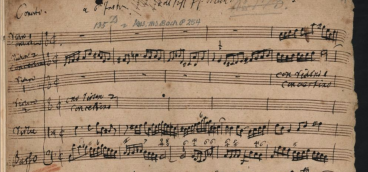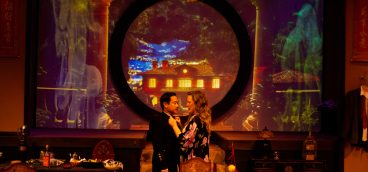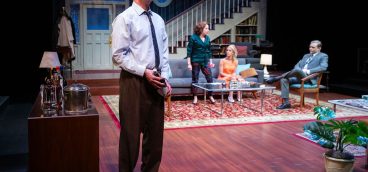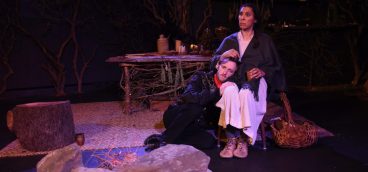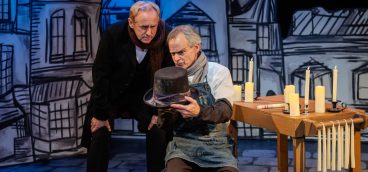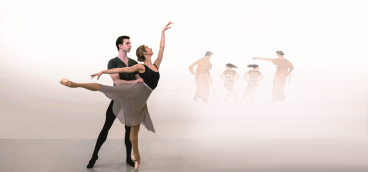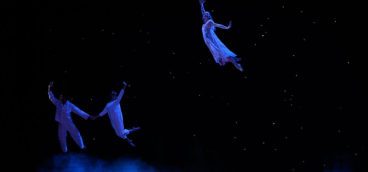The Time It Takes Between the Takes

In his celebrated writing workshop of the early 1990s, editor and literary guru Gordon Lish taught that one of the best ways to create an effective agon is to place divergent characters in a confined space – and let them act on their own volition, without smothering them in authorial intent. And that’s exactly what Barebones Productions has done with their new presentation of “The Shark is Broken” (2019), in that three people occupy a set the size of a Swedish hotel room, not as fictive characters, but in the roles of the real-life actors who starred in the 1975 blockbuster movie, “Jaws.”
In effect, we’re watching a kind of dramatic history – based on what co-writer Ian Shaw calls the “drinking diary” of his father Robert Shaw, who played the acerbic shark hunter Quint. Thus, this show is about actors playing actors who aren’t acting, as the action focuses on what happens when the cameras aren’t rolling, due to technical failures of the famous mechanical shark (whom the crew calls “Bruce”), as well as the myriad problems of filming at sea, not to mention bad weather, boats intruding into shots, script rewrites, and of course, frayed nerves. Whatever can go wrong does go wrong. And this is a lot of fun to watch, especially if you love seeing what happens behind the scenes when filming a major motion picture.
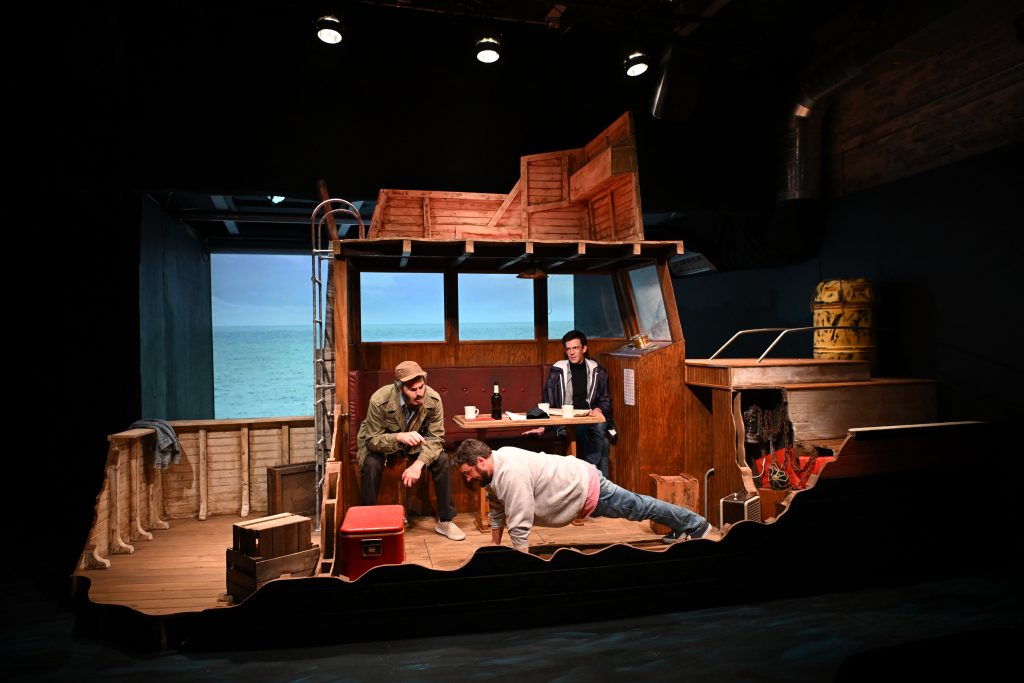
As the character Roy Scheider (Patrick Cannon) says, in the central line of the show, “It’s the time it takes between the takes that takes the time to take the take.” He could easily have said, “It’s the time it takes to drink between the takes . . .” as the Shaw character (Patrick Jordan) is an unabashed alcoholic, hiding bottles all over the set. The set is the claustrophobic inner cabin of the film’s boat, brilliantly designed by Tony Ferrieri, who is a master at making such spaces both functional and believable. The most intense scenes in the movie occur in this cabin, so the choice by the writers (the other being Joseph Nixon) to stuff all the action – and these three Hollywood egos – inside it is an enlightened one.
The third actor, Richard Dreyfuss (Quinn Patrick Shannon) plays Hooper, the nebbish and paranoid marine biologist, who is also very similar to his character. In fact, the clever reversal of the play is that the characters are really personifications of the actors; for instance, Shaw detests and berates Dreyfuss, just as Quint detests and berates Hooper. This is life imitating art, and now, within the play, becomes art imitating life.
Mr. Jordan, as Shaw/Quint, inhabits the role with bemused disdain. He goes beyond the script with his stage work in humiliating Dreyfuss/Hooper, for example, by knocking his hat off the table in a ritualist fashion, like a school bully would do. Mr. Jordan keeps Shaw’s English accent light, which allows him to modulate it in various degrees as his drinking progresses. The way he gently mangles the famous “Indianapolis” speech from the film during a take when he is too drunk to act is one of the high points of the evening.
As the Scheider/Chief Brody character, Mr. Cannon captures this actor’s nonchalant exterior which, if you know Scheider’s work, hides an edgy inner soul. It’s a tough assignment as Scheider was never considered one of the great actors of his generation but played the lead in two of the most important films of that decade: “Sorcerer” (1977) and “All That Jazz” (1979). Thus, he’s a more subtle persona to nail, and Mr. Cannon does so ably. He has the funniest line of the night when, in reading a contemporaneous newspaper story about Richard Nixon, he quips, “There will never be a more immoral president than Tricky Dicky,” which caused the audience to erupt in laughter.

Mr. Patrick Shannon has fun with the Dreyfuss/Hooper role, dressed as he is in that character’s trademark jeans, gray sweatshirt, and boat shoes. He’s a mess of words and mannerisms, full of himself but utterly naïve in the ways of the film industry – you don’t know where Hooper ends and Dreyfuss begins. He’s like a train running into itself again and again, a self-made wreck of a thespian who doesn’t trust his talent but never stops trying to match his two veteran co-stars.
One of the most effective elements of the production is the way in which the sea is projected behind the cabin, changing color over time, and darkening at night. You can even see gulls fly by. Thus, we as the audience never feel trapped, even if the three actors on the boat do.
Ultimately this is an experiential performance, which succeeds on the strength of the acting. Director Steve Parys’ pacing is fluid yet taut, and at 90 minutes the drama comes into port just when you want it to.
The play, like “Jaws,” is really a tripartite “buddy” vehicle, tinged with both tragedy and humor, while remaining unpredictable. And “The Shark is Broken” is the ironic backstory of this historic moment in cinematic history, revealing the often ugly side of filmmaking: the boredom of waiting around, the anxiety of being a performer building a career, working in a confined space, and dealing with difficult, egotistical people. The story of “Jaws” is ostensibly about a giant, man-eating creature, but it’s really, like all horror films, a journey of interiority, exploring fear and how we try to suppress it to survive. When Chief Brody utters the famous line in the film, “You’re going to need a bigger boat,” we realize that he might have been literally referring to their situation as actors, not just as characters, and that the line between life, film, and stage is much less significant than we would ever imagine.
THE SHARK IS BROKEN continues through June 15th at the Barebones Black Box Theatre, 1211 Braddock Ave., Braddock, $40-50. www.barebonesproductions.com
Note:
Unlike most theaters, every seat in Barebones’ Black Box space is superb, and unlike every other theater, this one has its own restaurant, Braddock Public House, under the same roof. Come for the drama; stay for the food and specialty cocktails. They even have a theme-based “New England-style” menu for this production, which is both creative and enticing. Why fight the crowds downtown when you can roll up like a rockstar for dinner and a show in stylish Braddock, and did I mention that parking is free?



